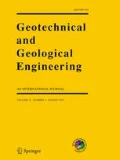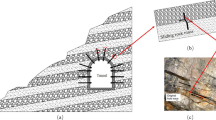Abstract
The truss bolt reinforcement system has been used in controlling the stability of underground excavations in severe ground conditions and cutter roof failure in layered rocks especially in coal mines. In spite of good application reports, working mechanism of this system is largely unknown and truss bolts are predominantly designed based on past experience and engineering judgement. In this study, the reinforcing effect of the truss bolt system on an underground excavation in layered rock is studied using non-linear finite element analysis. Different indicators are defined to evaluate the reinforcing effects of the truss bolt system. Using these indicators one can evaluate the effects of a reinforcing system on the deformation, loosened area, failure prevention, horizontal movement of the immediate layer, shear crack propagation and cutter roof failure of underground excavations. Effects of truss bolt on these indicators reveal the working mechanism of the truss bolt system. To illustrate the application of these indicators, a comparative study is conducted between three different truss bolt designs. It is shown that the design parameters of truss bolt systems, including tie-rod span, length, and angle of the bolts can have significant effects on the reinforcing capability of the system.



















Similar content being viewed by others
References
ABAQUS (2010) Finite element propgram. Dassault Systèmes Simulia Crop. (Dassault Systèmes, 2010), Providence
Altounyan P, Taljaard D (2001) Developments in controlling the roof in south african coal mines: a smarter approach. J S Afr Inst Min Metall 101:33–40
Bergman SG, Bjurstrom S (1984) Swedish experience of rock bolting: a keynote lecture. In: Rock bolting: theory and application in mining and underground construction, Proceedings of the international symposium, Abisko, pp 243–255
Brady B, Brown E (2005) Rock mechanics for underground mining, 3rd edition. Kluwer, Dordrecht
Coggan J, Gao F, Stead D, Elmo D (2012) Numerical modelling of the effects of weak immediate roof lithology on coal mine roadway stability. Int J Coal Geol 90-91:100–109
Cox R (2003) Mine roof truss-support systems technology. Min Eng 55(10):49–56
Cox RM, Cox M (1978) Design and application of the mine roof truss system in the illinois coal basin. In: Proceedings, first conference on ground control problems in thw Illinois Coal Basin, Carbondale, IL, pp 124–135
Deb D, Das KC (2011) Modelling of fully grouted rock bolt based on enriched finite element method. Int J Rock Mech Min Sci 48(2):283–293
Duarte AVC, Rochinha FA, do Carmo EGD (2000) Discontinuous finite element formulations applied to cracked elastic domains. Comput Methods Appl Mech Eng 185(1):21–36
Gadde M, Peng S (2005) Numerical simulation of cutter roof failure under weak roof conditions. In: 2005 SME annual meeting: got mining—Preprints, pp 459–469
Gambrell S, Crane P (1986) Support characteristics of classic and in-cycle trusses (a photoelastic comparison). In: Rock mechanics: key to energy production, Proceedings of the 27th US symposium on rock mechanics, Tuscaloosa, Code 8628, pp 505–511
Gambrell S, Haynes C (1970) In-situ roof trusses vs. angle roof bolts, a photoelastic comparison. Trans Soc Min Eng AIME 247(2):109–110
Ghabraie B, Ren G, Xie Y, Ghabraie K (2012) Study of truss bolt systems for highly stressed rock mass using finite element modelling techniques. In: 11th Australian—New Zealand conference on geomechanics, ground engineering in a changing world, Melbourne, pp 1177–1182
Ghabraie K, Xie Y, Huang X (2008) Shape optimization of underground excavation using eso method. In: 4th International structural engineering and construction conference, ISEC-4—innovations in structural engineering and construction, Melbourne, Code 74051, vol 2, pp 877–882
Hoek E, Brown T (1980) Underground excavations in rock. The Institution of Mining and Metallurgy, 44 Portland Place
Hoek E, Kaiser P, Bawden W (1998) Support of underground excavations in hard rock. Taylor & Fransic, London
Huang Z, Broch E, Lu M (2002) Cavern roof stability - mechanism of arching and stabilization by rockbolting. Tunn Undergr Space Technol 17(3):249–261
Jing L (2003) A review of techniques, advances and outstanding issues in numerical modelling for rock mechanics and rock engineering. Int J Rock Mech Min Sci 40(3):283–353
Karanam UMR, Dasyapu SK (2005) Experimental and numerical investigations of stresses in a fully grouted rock bolts. Geotech Geol Eng 23:297–308
Lang T, Bischoff J (1984) Stability of reinforced rock structures. In: ISRM symposium: design and performance of underground excavation, Cambridge, Code 7669, pp 11–18
Lang TA (1961) Theory and practice of rock bolting. In: Transaction of the AIME 220, pp 333–348
Lang TA, Bischoff JA (1982) Stabilization of rock excavations using rock reinforcement. In: Proceedings 23rd symposium on rock mechanics, Berkeley, Code 1727, pp 935–944
Li C (2006) Rock support design based on the concept of pressure arch. Int J Rock Mech Min Sci 43(7):1083–1090
Li X, Liu B, Tao L, Zhou Y (1999) The design of and experimental study on lateral behavior of truss-bolt system. In: Proceedings of the ’99 international symposium on mining science and technology, Beijing, Code 60268, pp 431–434
Liu B, Tao L, Tao L, Li X (2001) Numerical simulation of truss-bolt reinforcing jointed rock and its application. In: Proceedings of the 29th international symposium on computer applications in the mineral industries, Beijing, Code60475, pp 669–672
Liu B, Yue Z, Tham L (2005) Analytical design method for a truss-bolt system for reinforcement of fractured coal mine roofs: illustrated with a case study. Int J Rock Mech Min Sci 42(2):195–218
Maghous S, Bernaud D, Couto E (2012) Three-dimensional numerical simulation of rock deformation in bolt-supported tunnels: a homogenization approach. Tunn Undergr Space Technol 31(0):68–79 doi:10.1016/j.tust.2012.04.008
Neall GM, Haycocks C, Townsend JM, Johnson III LP (1977) Influence of some critical design parameters on roof truss support capacity: a preliminary report. AIME-Society of Mining Engineering, New York, pp 228–233
Neall GM, Haycocks C, Townsend JM, Johnson III LP (1978) Optimizing roof truss installations with body-loaded photoelastic models. Min Eng (NY) 30(5):660–666
O’Grady P, Fuller P (1992) Design considerations for cable truss secondary supports in roadways of underground collieries. In: Proceedings of the 11th international conference on ground control in mining, Wollongong, Code17409, pp 240–248
Osgoui R, Oreste P (2007) Convergence-control approach for rock tunnels reinforced by grouted bolts, using the homogenization concept. Geotech Geol Eng 25:431–440
Peng S, Tang D (1984) Roof bolting in underground mining: a state-of-the-art review. Geotech Geol Eng 2(1):1–42
Roy S, Rajagopalan AB (1997) Analysis of rockbolt reinforcement using beam-column theory. Int J Numer Anal Meth Geomech 21(4):241–253
Seegmiller B, Reeves J (1990) Truss performance at dutch creek mine, Colorado. Colliery guardian Redhill 238(6):164, 165–166
Sheorey P, Verma B, Singh B (1973) An analysis of the roof truss. J Mines Metals Fuels 21(8):233–236
Stankus J, Guo S, Mccaffrey J, Peng S (1996) Innovative concept in tailgate entry support: elimination of crib blocks through utilization of new high-capacity roof truss systems. Min Eng 48(9):57–62
Su W, Peng S (1987) Cutter roof and its causes. Min Sci Technol 4:113–132
Wahab Khair A (1984) Physical and analytical modeling of the behavior of truss bolted mine roofs. In: Rock bolting: theory and application in mining and underground construction, Proceedings of the international symposium, Abisko, Code 5695, pp 125–142
White CC (1969) Mine roof support system (united states patent no. 3427811)
Zhu F, Young D (1999) Analysis of roof truss for underground support. In: Proceedings of the 3rd national conference on geo-engineering for underground facilities, Urbana, Code55193, 90, pp 507–513
Author information
Authors and Affiliations
Corresponding author
Rights and permissions
About this article
Cite this article
Ghabraie, B., Ren, G., Ghabraie, K. et al. A Study on Truss Bolt Mechanism in Controlling Stability of Underground Excavation and Cutter Roof Failure. Geotech Geol Eng 31, 667–682 (2013). https://doi.org/10.1007/s10706-013-9617-7
Received:
Accepted:
Published:
Issue Date:
DOI: https://doi.org/10.1007/s10706-013-9617-7




